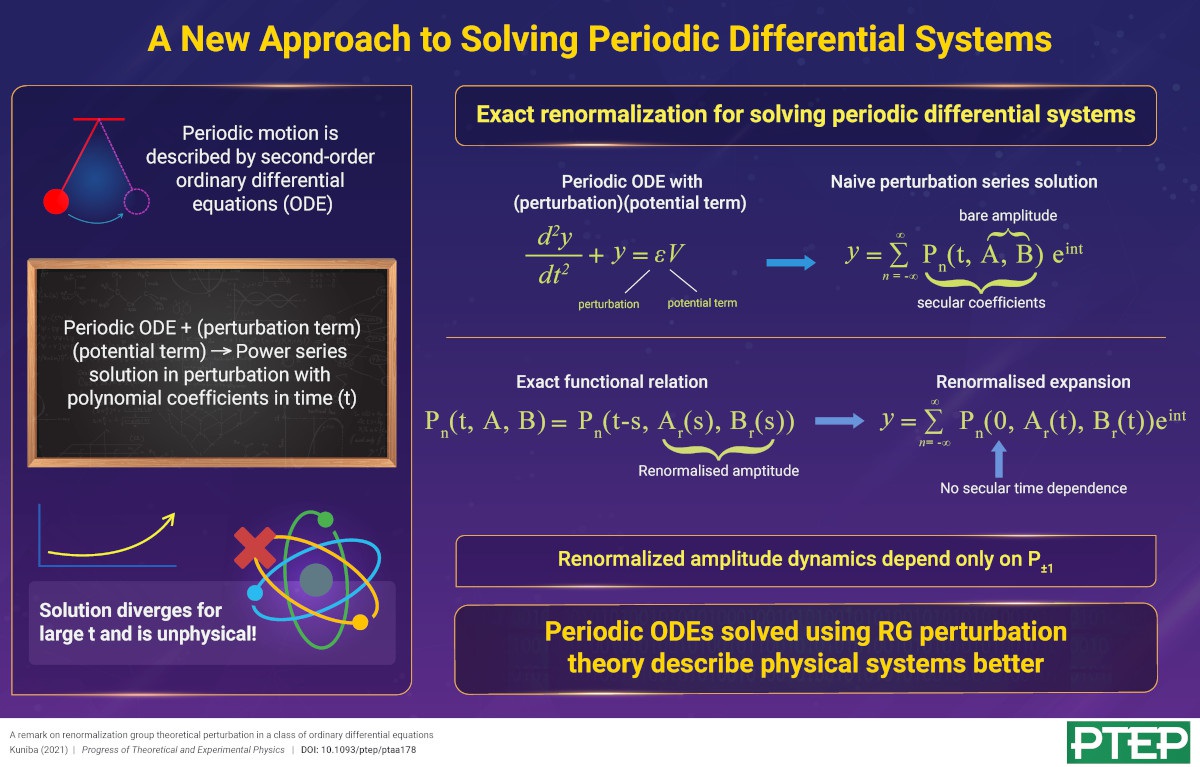A New Approach to Solving Periodic Differential Systems
© The Physical Society of Japan
This article is on
A remark on renormalization group theoretical perturbation in a class of ordinary differential equations
(PTEP Editors' Choice)
Prog. Theor. Exp. Phys. 2021, 013A02 (2021).
Mathematicians and physicists are well acquainted with second-order ordinary differential equations (ODE), the most prominent of them being the class of equations that govern oscillatory motion.

Mathematicians and physicists are well acquainted with second-order ordinary differential equations (ODE), the most prominent of them being the class of equations that govern oscillatory motion. Often, these oscillatory-type equations involve an inhomogeneous “potential” term coupled with a perturbation term and are usually solved as a power series in the perturbation with coefficients that are polynomials in the independent variable. However, when describing time-dependent behavior of a system, i.e., the independent variable is time (t), the series solution becomes problematic due to the coefficients diverging in time, which limits the valid description of the system to time scales of the order of (1/perturbation).
In a new study, I report on an elegant (yet unnoticed) functional identity in renormalization group (RG) theoretical perturbation theory, which is useful to get rid of the divergent time-dependence and to replace it instead with a description based on “renormalized amplitudes” and their time dynamics.
I begin with a second-order ODE in time with a potential term depending on the perturbation, the independent variable and its derivative, and the “resonant harmonics,” e±it, and its naïve perturbation series solution. Next, I write the dependent variable, say y, as a perturbation series expansion and substitute it in the ODE to get an equation for each power of the perturbation. I define Y as the resulting formal solution of the power series expansion of y and write it as a Fourier expansion with coefficients that are functions of what I call “bare amplitudes,” A, B. I will formally refer to them as “secular coefficients.”
I go on to prove an identity and a relation between the secular coefficients that are key to my results. I next define the “renormalized amplitudes” Ar(t) and Br(t) as a function of the “resonant” secular coefficient and use the proved relation to express the bare amplitudes as a function of Ar(t) and Br(t). Using the identity proved before, I further establish the renormalized series expansion in terms of Ar and Br, which is free from the secular time dependence.
Further, the dynamics of Ar(t) and Br(t) is solely determined by the resonant secular coefficients to all orders of perturbation.
This work has important implications in studies involving the classic cases of Van der Pol, Mathieu, Duffing, and Rayleigh equations and may trigger new theoretical development of a RG-based approach to solving differential equations.
A remark on renormalization group theoretical perturbation in a class of ordinary differential equations
(PTEP Editors' Choice)
Prog. Theor. Exp. Phys. 2021, 013A02 (2021).
Share this topic
Fields
Related Articles
-
Quantum Mechanics of One-Dimensional Three-Body Contact Interactions
Mathematical methods, classical and quantum physics, relativity, gravitation, numerical simulation, computational modeling
Theoretical Particle Physics
2024-2-13
The quantum mechanical description of topologically nontrivial three-body contact interactions in one dimension is not well understood. This study explores the Hamiltonian description of these interactions using the path-integral formalism.
-
Exploring Recent Advances in the Physics of Biofluid Locomotion
Measurement, instrumentation, and techniques
Cross-disciplinary physics and related areas of science and technology
Electromagnetism, optics, acoustics, heat transfer, and classical and fluid mechanics
Statistical physics and thermodynamics
Mathematical methods, classical and quantum physics, relativity, gravitation, numerical simulation, computational modeling
Structure and mechanical and thermal properties in condensed matter
2023-12-8
This Special Topics Edition of the JPSJ describes the latest advances in the field of biofluid locomotion, shedding light on the underlying physics behind the movement of organisms that swim and fly.
-
Topological Properties of the Periodic Toda Lattice: Analogy with the Thouless Pump
Mathematical methods, classical and quantum physics, relativity, gravitation, numerical simulation, computational modeling
Electronic structure and electrical properties of surfaces and nanostructures
2023-8-8
We find that the periodic Toda lattice belongs to the same topological class as the Thouless pump.
-
Towards a New Phase in Materials Science with Hyperordered Structures
Structure and mechanical and thermal properties in condensed matter
Cross-disciplinary physics and related areas of science and technology
Dielectric, optical, and other properties in condensed matter
Electron states in condensed matter
Atomic and molecular physics
Mathematical methods, classical and quantum physics, relativity, gravitation, numerical simulation, computational modeling
2023-5-1
A Special Topics edition of the Journal of the Physical Society of Japan features articles discussing recent advancements in hyperordered structures in materials, their applications, and the techniques for observing them.
-
Tensor Networks Across Physics
Mathematical methods, classical and quantum physics, relativity, gravitation, numerical simulation, computational modeling
Statistical physics and thermodynamics
Magnetic properties in condensed matter
2022-6-7
Researchers from Japan provide the first comprehensive review of the historical development of tensor networks from a statistical mechanics viewpoint, with a focus on its theoretical background.
